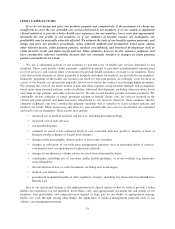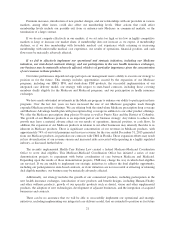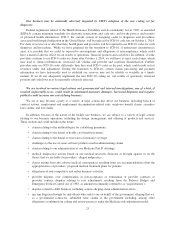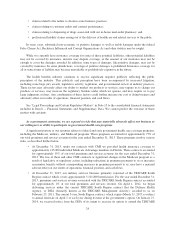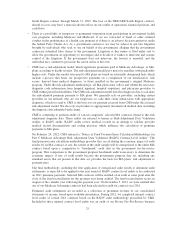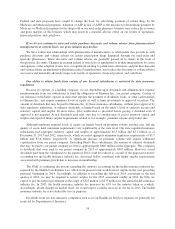Humana 2013 Annual Report Download - page 37
Download and view the complete annual report
Please find page 37 of the 2013 Humana annual report below. You can navigate through the pages in the report by either clicking on the pages listed below, or by using the keyword search tool below to find specific information within the annual report.reduction in our obligations to providers. Due to the uncertainty around the application of any such
reductions, there can be no assurances that we can completely offset any reductions to the Medicare
healthcare programs applied by the Budget Control Act of 2011.
• We are also subject to various other governmental audits and investigations. Under state laws, our
HMOs and health insurance companies are audited by state departments of insurance for financial and
contractual compliance. Our HMOs are audited for compliance with health services by state
departments of health. Audits and investigations are also conducted by state attorney generals, CMS,
the Office of the Inspector General of Health and Human Services, the Office of Personnel
Management, the Department of Justice, the Department of Labor, and the Defense Contract Audit
Agency. All of these activities could result in the loss of licensure or the right to participate in various
programs, including a limitation on our ability to market or sell products, the imposition of fines,
penalties and other civil and criminal sanctions, or changes in our business practices. The outcome of
any current or future governmental or internal investigations cannot be accurately predicted, nor can we
predict any resulting penalties, fines or other sanctions that may be imposed at the discretion of federal
or state regulatory authorities. Nevertheless, it is reasonably possible that any such outcome of
litigation, penalties, fines or other sanctions could be substantial, and the outcome of these matters may
have a material adverse effect on our results of operations, financial position, and cash flows. Certain
of these matters could also affect our reputation. In addition, disclosure of any adverse investigation or
audit results or sanctions could negatively affect our industry or our reputation in various markets and
make it more difficult for us to sell our products and services.
Recently implemented health care reform, including The Patient Protection and Affordable Care Act and
The Health Care and Education Reconciliation Act of 2010, could have a material adverse effect on our
results of operations (including restricting revenue, enrollment and premium growth in certain products and
market segments, restricting our ability to expand into new markets, increasing our medical and operating
costs by, among other things, requiring a minimum benefit ratio on insured products, lowering our Medicare
payment rates and increasing our expenses associated with a non-deductible health insurance industry fee
and other assessments); our financial position (including our ability to maintain the value of our goodwill);
and our cash flows. In addition, if we are unable to adjust our business model to address the non-deductible
health insurance industry fee and other assessments, including a three-year commercial reinsurance fee, such
as through the reduction of our operating costs or adjustments to premium pricing or benefit design, there can
be no assurance that the non-deductible health insurance industry fee and other assessments would not have a
material adverse effect on our results of operations, financial position, and cash flows.
The Patient Protection and Affordable Care Act and The Health Care and Education Reconciliation Act of
2010 (which we collectively refer to as the Health Care Reform Law) enacted significant reforms to various
aspects of the U.S. health insurance industry. While regulations and interpretive guidance on many provisions of
the Health Care Reform Law have been issued to date by the Department of Health and Human Services, or
HHS, the Department of Labor, the Treasury Department, and the National Association of Insurance
Commissioners, there are certain provisions of the law that will require additional guidance and clarification in
the form of regulations and interpretations in order to fully understand the impact of the law on our overall
business.
The provisions of the Health Care Reform Law include, among others, imposing a significant new non-
deductible health insurance industry fee and other assessments on health insurers, limiting Medicare Advantage
payment rates, stipulating a prescribed minimum ratio for the amount of premiums revenue to be expended on
medical costs for insured products, additional mandated benefits and guarantee issuance associated with
commercial medical insurance, requirements that limit the ability of health plans to vary premiums based on
assessments of underlying risk, and heightened scrutiny by state and federal regulators of our business practices,
including our Medicare bid and pricing practices. The Health Care Reform Law also specifies benefit design
guidelines, limits rating and pricing practices, encourages additional competition (including potential incentives
27




